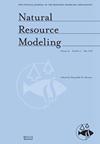Strong Allee effect and basins of attraction in a discrete‐time zoonotic infectious disease model
IF 2.1
4区 环境科学与生态学
Q3 ENVIRONMENTAL SCIENCES
引用次数: 0
Abstract
Motivated by the Feline immunodeficiency virus, the virus that causes AIDS in cat populations, we use discrete‐time infectious disease models with demographic strong Allee effect to examine the impact of the fatal susceptible‐infected (SI) infections on two different types of growth functions: Holling type III or modified Beverton–Holt per‐capita growth function (compensatory density dependence), and Ricker per‐capita growth function with mating (overcompensatory density dependence). The occurrence of the strong Allee effect in the disease‐free equation renders the SI population model bistable, where the two coexisting locally asymptotically stable equilibrium points are either the origin (catastrophic extinction state) and the second fixed point (compensatory dynamics) or the origin and an intrinsically generated demographic period k > 1 population cycle (overcompensatory dynamics). We use the basic reproduction number, ℛ 0 , and the spectral radius, λ k , to examine the structures of the coexisting attractors. In particular, we use MATLAB simulations to show that the fatal disease is not only capable of enlarging or shrinking the basin of attraction of the catastrophic extinction state, but it is also capable of fracturing the basins of attraction into several disjoint sets. Thus, making it difficult to specify the asymptotic zoonotic SI disease outcome in terms of all initial infections. The complexity of the basins of attractions appears to increase with an increase in the period of the intrinsically generated demographic population cycles.离散时间人畜共患传染病模型中的强Allee效应和吸引盆地
受猫免疫缺陷病毒(在猫群中引起艾滋病的病毒)的影响,我们使用具有人口统计学强Allee效应的离散时间传染病模型来检验致命易感感染(SI)感染对两种不同类型生长功能的影响:Holling III型或改良的Beverton-Holt人均生长函数(代偿密度依赖)和Ricker人均生长函数(过度代偿密度依赖)。无病方程中强Allee效应的出现使得SI种群模型双稳态,其中两个共存的局部渐近稳定平衡点要么是原点(灾难性灭绝状态)和第二个不动点(补偿动力学),要么是原点和内在产生的人口周期k >1种群周期(过度补偿动力学)。我们使用基本复制数,∑0和谱半径,λ k来检验共存吸引子的结构。特别地,我们使用MATLAB仿真表明,致命疾病不仅能够扩大或缩小灾难性灭绝状态的吸引盆地,而且还能够将吸引盆地破碎成几个不相交的集。因此,就所有初始感染而言,很难确定渐近人畜共患SI疾病的结果。吸引力盆地的复杂性似乎随着内在产生的人口周期的增加而增加。
本文章由计算机程序翻译,如有差异,请以英文原文为准。
求助全文
约1分钟内获得全文
求助全文
来源期刊

Natural Resource Modeling
环境科学-环境科学
CiteScore
3.50
自引率
6.20%
发文量
28
审稿时长
>36 weeks
期刊介绍:
Natural Resource Modeling is an international journal devoted to mathematical modeling of natural resource systems. It reflects the conceptual and methodological core that is common to model building throughout disciplines including such fields as forestry, fisheries, economics and ecology. This core draws upon the analytical and methodological apparatus of mathematics, statistics, and scientific computing.
 求助内容:
求助内容: 应助结果提醒方式:
应助结果提醒方式:


